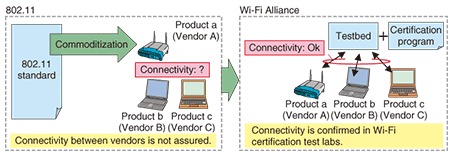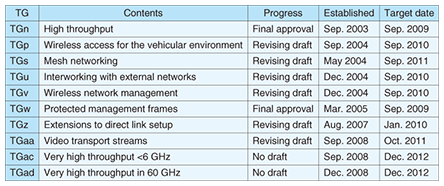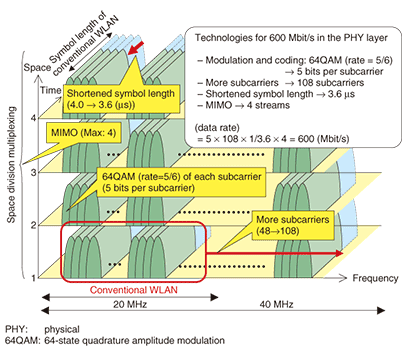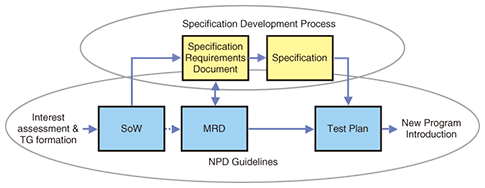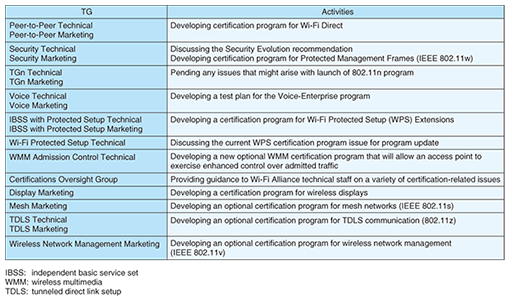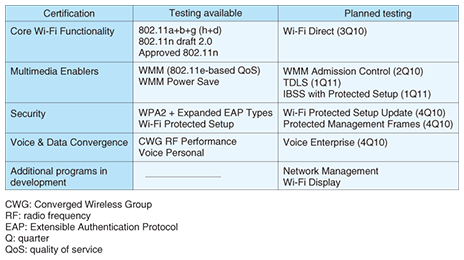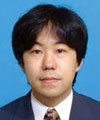 |
|||||||||
|
|
|||||||||
|
Global Standardization Activities Vol. 8, No. 4, pp. 24–30, Apr. 2010. https://doi.org/10.53829/ntr201004gls Wireless Local Area Network Standardization of IEEE 802.11 and the Wi-Fi AllianceAbstractWe explain the latest trends and recent activities related to the standardization of wireless local area network (WLAN) systems, which has been carried out mainly by IEEE 802.11 and the Wi-Fi Alliance. IEEE 802.11 standardizes WLAN technical specifications enabling WLAN interconnection. The Wi-Fi Alliance creates certification programs for WLAN products and grants Wi-Fi certification to products that pass its certification tests.
1. Features of IEEE 802.11 and the Wi-Fi AllianceThe standardization of wireless local area network (WLAN) systems has been carried out mainly by IEEE 802.11 [1] and the Wi-Fi Alliance [2]. The relationship between these two organizations is shown in Fig. 1.
IEEE 802.11 is one of the Working Groups (WGs) of the Institute of Electrical and Electronics Engineers (IEEE), an international standardization organization dealing with LANs. IEEE 802.11, whose main role is developing technical specifications for WLAN implementation, issued its first standard “IEEE 802.11” in 1997. Since then, it has issued amendments for high-speed access at up to 54 Mbit/s (802.11a, 802.11b, and 802.11g), security (802.11i), quality of service (802.11e), and other areas. Meanwhile, there is a remaining issue: there are cases where interconnection between different vendors cannot be achieved even though the WLAN devices meet the IEEE 802.11 standards. Therefore, in August 1999, WLAN vendors established the Wireless Ethernet Compatibility Alliance to ensure interconnectivity. The group was renamed the Wi-Fi Alliance and is currently working to resolve this issue. Since 2000, the Wi-Fi Alliance has worked with its members to complete more than 6000 product certifications. Through comprehensive testing, the Wi-Fi Alliance certification program ensures that WLAN products from multiple manufacturers work together. In other words, if you purchase Wi-Fi certified products, you can connect to other Wi-Fi certified products with the latest security features. 2. Standardization procedure of IEEE 802.11Study Groups (SGs) are established before Task Groups (TGs). SGs set the scope and goals of activities to be conducted by TGs. If those items are approved, a TG can start carrying out its activities. The process of standardization depends on each TG but, in general, a TG initially examines the technical issues and functional requirements required to achieve the goals of activities, and participants then propose technologies for consideration to satisfy those requirements. If the proposed technologies are approved by other participants, then drafts for those technologies are created and submitted for deliberation and approval at the WG level. In the deliberations, participants who have voting rights vote for approval and can attach comments. The cycle of deliberation and revision of drafts is repeated and if the IEEE 802 committee grants approval (final approval), the proposed technologies will be issued as standards. 3. Aspects of IEEE 802.11 standardizationThe standardization work of the IEEE 802.11 WG is conducted in TGs. The TGs that were in operation as of November 2009 are listed in Table 1. Among these, TGs is addressing the installation of a relay function in each 802.11 device to allow their use in a mesh network, TGu is tackling interworking with standards other than 802.11 such as the third-generation cellular phone or 802.16, and TGv is standardizing wireless network management to advance functionalities such as multiple BSSIDs (basic service set identifiers) and multicast. These TGs have already created drafts of amendments and are working to complete their tasks.
TGn and TGw have substantially completed standardization work and were seeking final approval of their draft work as of September 2009. For the high-throughput WLAN systems being standardized in TGn, the growing need to launch them at the earliest possible time led to a number of draft-based devices being released onto the market without waiting for final approval. Standardization work on IEEE 802.11ac and IEEE 802.11ad (advanced versions of IEEE 802.11n) has also begun in TGac and TGad, respectively, with the goal of even faster Internet access. 4. Review of fast connectionsOne of the major trends in the IEEE 802.11 standard is high throughput. The first 802.11 standard had a maximum data rate of 2 Mbit/s. The maximum data rate was increased to 11 Mbit/s (802.11b) and 54 Mbit/s (802.11a and 802.11g). Most recently, 802.11n with a maximum data rate of 600 Mbit/s acquired final approval in September 2009. The increases in data rate have been achieved through the combination of multiple technologies, including MIMO (multi-input multi-output), as shown in Fig. 2.
Aiming at higher throughput, a TG for the 6-GHz frequency band or below, TGac (established in September 2008), and another TG for the 60-GHz frequency band, TGad (established in December 2008), are working to complete standardization by 2012 (Table 2).
TGac is reviewing a novel method that uses multiple antenna technologies including multiuser MIMO technology, which is an advanced MIMO technology that provides simultaneous transmission across multiple terminals. At a meeting held in Atlanta, USA, in November 2009, four special ad-hoc groups were established within TGac to review the details of those technologies. Meanwhile, TGad has been working with the aim of expanding transmission bandwidth. TGad has started accepting technology proposals for draft creation. The deadline for Full Proposals has been set as May 2010. Both TGs are expected to shift into full swing to study the proposed technologies in detail in the near future. 5. Wi-Fi certification program formulation procedureHere, we explain the procedure for formulating Wi-Fi certification programs. Wi-Fi certification programs are formulated by the New Program Development (NPD) guidelines by using the Specification Development Process (SDP), which is out of the scope of the NPD Guidelines (Fig. 3). The programs’ formulation procedure and the roles of the Wi-Fi Alliance TGs are described below. Current TG and activities are listed in Table 3.
If ten or more member companies are interested in new topics and activities, a Member Interest Meeting is sanctioned by the Wi-Fi Alliance Board of Directors (BoD). At that meeting, if ten or more members with voting rights are interested in those ideas and activities, a new Marketing TG (MTG) will be established. In the MTG, a Statement of Work (SoW) and a Marketing Requirements Document (MRD) are created. The SoW sets out the basic requirements for the SDP. The MRD defines which elements of the Specification Requirements Document should be embedded in the targeted Wi-Fi program. After that, if twelve products are expected to be certified by eight member companies in the first year of program startup, a Technical TG (TTG) is established and a Wi-Fi test plan is developed for the Wi-Fi certification. As the next step, a plugfest is held by member companies for testbed development, device selection, and connectivity verification. Plugfests should be conducted every three months or less. Plugfest participation should include at least five access points, five clients, three chipsets, and two frequency bands (5 × 5 × 3 × 2) for certification devices, and four access points, four clients, three chipsets, and two frequency bands (4 × 4 × 3 × 2) for testbed devices. After the final decision on and release of the test plan as well as the final decision on the testbed, achieved by implementing a New Program Introduction, the startup and verification of each program is carried out. Approval from the Wi-Fi Alliance BoD is required before each document is issued and for TG formation. 6. Wi-Fi certification programs prior to IEEE 802.11 standardizationAs IEEE 802.11 standardization takes some time, Wi-Fi certification needs to be started without waiting for the completion of IEEE 802.11 standards. When the security weakness of WEP (Wired Equivalent Privacy) of IEEE 802.11 was pointed out, standardization of IEEE 802.11i (security) was still in progress. However, the Wi-Fi Alliance concluded that waiting for the completion of the standardization would unduly slow the expansion of the WLAN market, so it specified those functions that were close to completion from among IEEE 802.11i drafts. It named them Wi-Fi Protected Access (WPA). This helped to ensure security at the time. Since then, WPA has been developed into WPA 2 certification and, along with the completion of the IEEE 802.11i standard, has become an essential item of basic Wi-Fi certification. As for IEEE 802.11n, the Wi-Fi Alliance started issuing 802.11n Draft 2.0 certification in June 2007. When the IEEE 802.11n Draft 2.0 was released in March 2007, the Wi-Fi Alliance concluded that future discussions at IEEE 802.11 would have little influence on those basic functions and connectivity and decided to make certified programs prior to standardization by IEEE 802.11; the programs were based on the contents of 802.11n certification discussions. This enabled WLAN chipsets and devices for 802.11n Draft 2.0 certification to be introduced and high-speed WLAN access to be established with high security. Immediately after TGn was approved by IEEE 802.11 on September 30, 2009, the Wi-Fi Alliance started providing TGn-based certification. At the same time, Draft 2.0-based certified devices also began to be automatically approved as TGn certified devices. 7. Recent activities of the Wi-Fi AllianceThe Wi-Fi Alliance has recently been formulating various certification programs based on IEEE 802.11 standards. Current Wi-Fi certification program and future plans are listed in Table 4.
In January 2007, Wi-Fi Protected Setup (WPS) certification began with the aim of achieving easier setting up of WLAN devices and security functions. Because this technology is not included in the IEEE 802.11 standards, each vendor has been implementing its own WLAN setup procedure. Therefore, the Wi-Fi Alliance started standardizing technologies for easy setup and performed connectivity certification between WPS-certified devices. In September 2009, the Wi-Fi Alliance introduced specifications for Wi-Fi Direct, which connects WLAN terminals via peer-to-peer technology. It operates on 802.11 devices but is not linked to any specific IEEE 802.11 amendment. The certification process for that is expected to start in mid-2010. This technology allows Wi-Fi devices to be connected with high security without any access points. It will let users print out documents or other things by directly connecting a printer equipped with Wi-Fi functions to a laptop or cellular phone that has Wi-Fi functions and will also enable the sharing of Internet connections. Meanwhile, the Wi-Fi Alliance is considering utilizing conventional technologies to develop a Smart Grid, which uses information technology in the energy supply industry. In November 2009, the white paper “Wi-Fi for the Smart Grid” was released. Wi-Fi technologies with high security and stable functions will be utilized to establish various Smart Grid applications. Furthermore, in cooperation with IEEE, the Wi-Fi Alliance will be able to extend the scope of applicability in order to meet users’ future needs such as 802.11s (mesh networking) and 802.11u (interworking with external networks). 8. Concluding remarksIEEE 802.11 and the Wi-Fi Alliance have been contributing to technology innovation in the field of WLAN systems through close cooperation on faster, easier-to-use, and advanced functions. References
|
|||||||||








